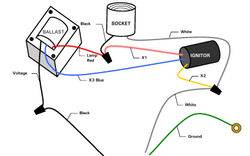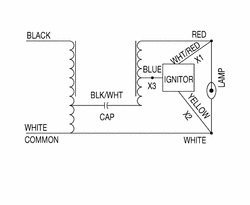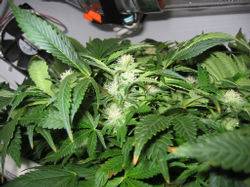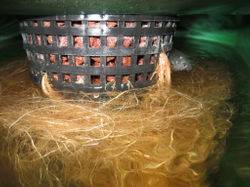-
Happy Birthday ICMag! Been 20 years since Gypsy Nirvana created the forum! We are celebrating with a 4/20 Giveaway and by launching a new Patreon tier called "420club". You can read more here.
-
Important notice: ICMag's T.O.U. has been updated. Please review it here. For your convenience, it is also available in the main forum menu, under 'Quick Links"!
You are using an out of date browser. It may not display this or other websites correctly.
You should upgrade or use an alternative browser.
You should upgrade or use an alternative browser.
150w HPS Club and Resource Guide......
- Thread starter Pipedream
- Start date
G
Guest
Vern thats some nice engineering there! I wasnt even thinking about the wires! DUH  Im not sure about the yield heres why: The 2 clones in the tub on the right were taken from my Shishkaberry when she was flowering. Heres one of the Shishkaberrys from last go re-vegging. I think I cut them late Feb...?
Im not sure about the yield heres why: The 2 clones in the tub on the right were taken from my Shishkaberry when she was flowering. Heres one of the Shishkaberrys from last go re-vegging. I think I cut them late Feb...?

Shes a sativa dominant strain, pretty slow, low odor. Fluff buds. This trait makes me think that the strain on the left will surpass it in yield even though its a week or 2 behind in veg.
The strain on the left Jam shows hybrid characteristics. Fast growing, vigorous, fast to flower, tight internodal spacing. I kept the healthiest clone for a mom:

I cant be sure so I like to be pessimistic, lets say 1oz for the 2 on the left, .8oz for the 2 on the right. This could be totally bogus though I havent flowered this Jam strain before, therefore I dont know how long she will want to flower. This is also my first try with a C25, and also my first hydro attempt. And my first scrog. Wish me luck!
The sun is about to come up in my C25 so Ill go snap some pics!
 Im not sure about the yield heres why: The 2 clones in the tub on the right were taken from my Shishkaberry when she was flowering. Heres one of the Shishkaberrys from last go re-vegging. I think I cut them late Feb...?
Im not sure about the yield heres why: The 2 clones in the tub on the right were taken from my Shishkaberry when she was flowering. Heres one of the Shishkaberrys from last go re-vegging. I think I cut them late Feb...?
Shes a sativa dominant strain, pretty slow, low odor. Fluff buds. This trait makes me think that the strain on the left will surpass it in yield even though its a week or 2 behind in veg.
The strain on the left Jam shows hybrid characteristics. Fast growing, vigorous, fast to flower, tight internodal spacing. I kept the healthiest clone for a mom:

I cant be sure so I like to be pessimistic, lets say 1oz for the 2 on the left, .8oz for the 2 on the right. This could be totally bogus though I havent flowered this Jam strain before, therefore I dont know how long she will want to flower. This is also my first try with a C25, and also my first hydro attempt. And my first scrog. Wish me luck!

The sun is about to come up in my C25 so Ill go snap some pics!
Last edited:
LazyGeezer
New member
Hi chaps,anyone using 150w in the UK.Where did you get it?I cant find one!Loads of lamps but thats it.Well idid find some for £250+,just want a cheap security light to convert.Cheers
G
Guest
Hows the weather Lazy? Try all the hardware/home improvement stores. They usually sell a good selection of HPS security lights. Maybe an electrical supply warehouse if not that. eBay could get you something, or as a last resort, go pay out the ass at a hydroponics store.
hey y'all
how's the 150 club going?
yeah lazy it can be hard to find an over-the-counter 150 watter - Lowe's is the only one here in the States that carries it - don't know if they have them in the UK or not.
hey user_name
hey all 150 growers !
how's the 150 club going?
yeah lazy it can be hard to find an over-the-counter 150 watter - Lowe's is the only one here in the States that carries it - don't know if they have them in the UK or not.
hey user_name
hey all 150 growers !
wiring diagram
wiring diagram
well thanks go out to Vernal for sending me a link to the PDF version of a wiring diagram provided by econolight...
I was able to create a JPG version to post here in case anyone needs it here it is...
Please note this diagram is for a unit with out a capacitor. I'll try to get a diagram for that and put it up here too.
-suga

wiring diagram
well thanks go out to Vernal for sending me a link to the PDF version of a wiring diagram provided by econolight...
I was able to create a JPG version to post here in case anyone needs it here it is...
Please note this diagram is for a unit with out a capacitor. I'll try to get a diagram for that and put it up here too.
-suga
Vern Equinox
Member
senseless, they probably have capacitors, but integrated into the ballasts.
Nice Kab O' Kush!
Nice Kab O' Kush!
senseless said:do you know why some 150w hps lights have no capacitors? both of mine dont have them.
well some do and some don't - here's the text of the original OG FAQ I pulled off of the google cache today, this explains what the capacitor does to the power factor and how this will not increase your electricity bill, but if you run many many lamps it could be noticable to the power company.
After I re-read this today I realized the most important point the author made was that you can overload the circuit as ones with bad power factors will draw around 4.4Amps at startup - if you had a 15A circuit as most houses do you would overload it with four 150watt hps lamps.
""How much power does my lamp really use?- [Find more information in the GrowFAQ]
Basil Fawlty || title:How much power does my lamp really use?|| ||author:Basil Fawlty|| ||forum:10||
Have you ever looked at your lamp and thought, "Hmm, the bulb says 150W but surely this ballast thingy must use some power too" Well if you did, you're absolutely right. Some people say that the rule of thumb is about 5-10% of the lamp's wattage. While this may be true for some ballasts it certainly isn't the case for all ballasts, particularly cheap HID (High Intensity Discharge) lamp ballasts.
We essentially want to know the ratio of the bulb wattage (W) to total input power (in VA):
This is called the Power Factor. It's formally defined as the ratio of active (measured in kW) to apparent (measured in kVA) power use. It's important to note that most power companies only charge you for active power use.
A good ballast will have a power factor above 0.9 (i.e. more than 90% of the power it draws is used to power the bulb). Cheaper (lower quality) ballasts often have power factors of 0.5 or less. That's right, only half of the power gets to the bulb. So a 150W lamp would be drawing over 300VA of power. Of course, the wiring in the ballast (e.g. tranformer) also dissipates power but we aren't going to take that into consideration.
Let's look at a real world example. Here's a 150W HPS lamp made by Globe. This lamp has been used for about 8 months (about 4-5000hrs).
OK, let's take our trusty multimeter and measure the voltage on our 120V line.
So now we've measured V = 121.6V. We now set our multimeter to measure AC current and plug the leads into the 10A slot on it.
WARNING! Never put the leads in the 10A slot for any purpose other than measuring current! Failure to heed this warning will at very least result in a tripped breaker and a blown fuse inside your multimeter, if you're lucky.
We then wire the leads in series with the black wires of the lamp. Let's turn on the lamp and see what the startup current looks like.
Holy cow! 4.4A! That means that it's using 121.6V x 4.4A = 535VA! Let's figure out the power factor at startup.
Power Factor = W / VA = 150 / (121.6 x 4.4) = 0.28!
That means that only 28% of the power is being used by the lamp. Another way to look at it is that it's drawing 3.5 times the power that's written on the bulb. Let's not forget that it's normal for HID ballasts to draw more juice at startup. So let's let it run for a while.
:bong:
After a good fifteen minutes has gone by, the light is at maximum intensity. Let's have a look at the current flowing through the circuit now!
As we can see, it has indeed dropped. It's now drawing 3.06A or 121.6 x 3.06 = 372VA! Let's figure out the power factor.
Power Factor = W / VA = 150 / (121.6 x 3.06) = 0.4
It's important to mention that as an HPS bulb ages, its input voltage increases so the ballast has to work harder to keep the bulb at 150W. I performed the same measurement when the bulb was almost new and it was drawing 2.6-2.7A at operating temperature then, which would give something closer to a more realistic power factor of 0.5. Since the power factor of the ballast doesn't change much over time, we can work backwards to determine the real power use of the lamp + balast. W = PF x V x A = 0.5 x 121.6 x 3.06 = 186W.
To answer our initial question, "How much power does my lamp really use?"
Bulb Wattage -> 150W
Apparent power used at startup -> 535VA
Apparent power used at operating -> 372VA
Real power used at operating -> 186W
I think the most important thing to learn here is that the power footprint of a 150W bulb on a low power factor ballast is almost as large as that of a 400W bulb with a high power factor ballast.
It should also be apparent that one should be careful about the assumptions they make when making calculations for the installation of electrical circuits. You may think that you can safely put 7-8 of these 150W lamps on a 15A circuit but guess again!
In the next installment, I'll show you how to add a power factor correction capacitor to increase the power factor of your el cheapo ballast.
(eventual link to http://www.overgrow.com/edge/showth...threadid=513232)
Further reading:
http://www.ballastdesign.com/overview.html
http://www.powerdown.net/PowerFactor.pdf
"
Here's the part about adding the capacitor
"Basil Fawlty || title:How do I increase the power factor of my lamp?|| ||author:Basil Fawlty|| ||forum:10||
Now that you’ve read How much power does your lamp really use? and determined that your ballast has a low power factor, you’re probably wondering if there’s something you can do about it or if you should even bother. Of course, there is something that you can do about it and in some places the power company can force you to do something about it if they determine that you have an average power factor below 0.9.
http://www.hydroquebec.com/publicat..._domestique.pdf
"When the power factor, measured at the delivery point, is usually less than 90 % for a small and medium power contract, or less than 95 % for a large power contract, the customer must install, at his expense, corrective equipment, when Hydro-Québec asks him to do so in writing; however, the corrected power factor must not become capacitive."
In other places, the power company will install a meter that takes into account your average power factor so that you get charged in kVA instead of kW.
http://www.hydroonenetworks.com/en/...ervice_full.pdf
"When a Customer’s power factor is known to be less than 90%, a kVA meter or other equivalent electronic meter shall be used for measuring and billing."
In either case, it's in your best interest to keep your overall power factor over 90% if you don't want the power company snooping around and asking you questions about your power use.
Before we go any further, let's define "Power Factor" a little more rigorously than we did in our previous installment. Power factor can be defined as the ratio of active (measured in kW) to apparent (measured in kVA) power. Yes, it does sound rather confusing when you consider that for purely resistive loads (e.g. electric baseboard heaters) there's a direct relationship between W and VA. This isn't the case for things like lamp ballasts and motors, which can have a significant inductive (reactive) component.
Now, if you were paying attention, you noticed that the power company typically charges you in kW and not kVA. That does technically mean that you aren't paying for the extra "power" that your el cheapo ballast uses because the meter doesn't register it (unless the power company installed a kVA meter for your service). However, that extra power is real as far as the switches and wires in your setup are concerned. If you've only got a single 150W HID lamp in your closet, it's probably not worth worrying about it. On the other hand, it should be apparent that this would affect the plans you had of installing a half dozen 150W lamps (900W total) that draw 500VA of power each (3000VA total) at startup on a 15A circuit (1800VA).
There are several ways of correcting power factor. Since we're talking about rather small loads, we'll investigate the simple capacitor method. We've previously determined that the power factor of our ballast with a new bulb is about 0.5 (often you can find the power factor on the ballast tag or on the website of the manufacturer). We also see that the current listed on the nameplate of the lamp is 3.2A @ 120V.
Note: our method for determining power factor wasn't quite technically accurate because it didn't take into account the resistive load of the transformer but it'll be close enough for the purposes of our exercise.
Apparent power = 120V x 3.2A = 384 VA
Active power = 0.5 x 384 = 192W (the real power usage of the lamp).
Reactive Power = sqrt (384^2 - 192^2) = ~332 VAR (we want to correct this)
We can calculate the required impedance from Q = E^2/X
X = E^2/Q = 120^2/332 = ~43 ohms
Now we want to find the matching capacitance.
Xc = 1 / (omega C) = 1 / (2 * pi * f * C)
For a 60Hz line this simplifies to
Xc = 1 / (2 * pi * 60 * C) = 1 / (377 * C)
Thus,
Xc = 1 / (377 * 43) = 61 uF
Let's put it into practice. We know from our previous experiment that our lamp was drawing 4.4A (535VA) at startup and 3.06A (372VA) at operating temperature. We don't have a 61 uF capacitor but we were able to borrow a 48 uF capacitor from another ballast that will be enough for our experiment.
(capacitor.jpg)
WARNING! Always discharge capacitors by shorting out their contacts before working with them! Once the capacitor is wired in parallel with your ballast, you can accomplish this by pressing the contacts of your plug against something metalic.
We connect the capacitor in parallel with the lamp. We then set our multimeter to measure AC current in the 10A configuration and connect it in series with our lamp+capacitor combination.
WARNING! Never put the leads in the 10A slot for any purpose other than measuring current! Failure to heed this warning will at very least result in a tripped breaker and a blown fuse inside your multimeter, if you're lucky.
(150W_corrected_startup.jpg)
As we can see, we went from a current of 4.4A to a mere 2.16A at startup. We'll let the lamp warm up to operating temperature and measure it again.
(150W_corrected_operating.jpg)
As expected, we succeeded in lowering the operating current from 3.06A to 1.447A with our power factor correction capacitor.
With a little math we see that we can plug a half dozen of these into a 15A circuit after our little modification.
2.16x6 = 12.96A
Of course, the cost and hassle of buying capacitors and installing them could be avoided by simply buying high power factor ballasts in the first place.
More info on power factor correction can be found here, http://home.earthlink.net/~jimlux/hv/pfc.htm
"
-suga
so here's my best attempt at a capacitor wired in parallel in the above wiring diagram.
Last edited:
Vern Equinox
Member
sugabear _II, I'm petitioning to change your nick to sugabear_cubed
Nice, nice post! Thanks so much for the effort. You've probably helped me to not burn the house down, as that info about the draw on your wires was some startling chit.
Nice, nice post! Thanks so much for the effort. You've probably helped me to not burn the house down, as that info about the draw on your wires was some startling chit.
Last edited:
G
Guest
senseless, your scrog looks awesome man! Looks like your roots are happy. be sure to keep us updated.
Hey suga, thats very good important information that you have posted. I was thinking that it should be posted in the security forum too. What do you think?
thats very good important information that you have posted. I was thinking that it should be posted in the security forum too. What do you think?
Whats up Vern?, hows the cab coming along?
Heres some pics of my stuff


These mothers need to be topped! They must feel cramped!

Check out what I scored today

Yay another strain! This one is called Chunk. Anyone heard of it? The smoke was killer, I wont lie. Real knockout, barely keep yer eyes open stuff. Tasty too!!! Im not certain that these are hermie seeds though. It seems that they were a lot more concentrated into a bud than any hermie seeds I have found. They are usually spread out more. Anyhow, I didnt see any hermies on the nug we were smokin, but we will see when (if) they get going. I could benefit from having a few dudes for breeding purposes.
Im not certain that these are hermie seeds though. It seems that they were a lot more concentrated into a bud than any hermie seeds I have found. They are usually spread out more. Anyhow, I didnt see any hermies on the nug we were smokin, but we will see when (if) they get going. I could benefit from having a few dudes for breeding purposes.
Hey suga,
 thats very good important information that you have posted. I was thinking that it should be posted in the security forum too. What do you think?
thats very good important information that you have posted. I was thinking that it should be posted in the security forum too. What do you think?Whats up Vern?, hows the cab coming along?
Heres some pics of my stuff


These mothers need to be topped! They must feel cramped!

Check out what I scored today

Yay another strain! This one is called Chunk. Anyone heard of it? The smoke was killer, I wont lie. Real knockout, barely keep yer eyes open stuff. Tasty too!!!
 Im not certain that these are hermie seeds though. It seems that they were a lot more concentrated into a bud than any hermie seeds I have found. They are usually spread out more. Anyhow, I didnt see any hermies on the nug we were smokin, but we will see when (if) they get going. I could benefit from having a few dudes for breeding purposes.
Im not certain that these are hermie seeds though. It seems that they were a lot more concentrated into a bud than any hermie seeds I have found. They are usually spread out more. Anyhow, I didnt see any hermies on the nug we were smokin, but we will see when (if) they get going. I could benefit from having a few dudes for breeding purposes.
Last edited:
senseless
Active member
you have some good lookin roots as well. is that a bubbler? and updated i will keep you.
thanks for that shuga thats super helpfull. are you an electrician by any chance?
somebody please want to tell me how to fix my signature so when you click on 'kabniet o kush' it links you to my grow?
thanks for that shuga thats super helpfull. are you an electrician by any chance?
somebody please want to tell me how to fix my signature so when you click on 'kabniet o kush' it links you to my grow?
G
Guest
senseless, click the hyperlink button when editing your signature. It will ask you what text you want to display, then it will ask you what the URL is. This is where you paste in the link address. Does this help?
Also, yes they are bubblers. 2 pumps each, one 10-inch bubble curtain per pump.
Also, yes they are bubblers. 2 pumps each, one 10-inch bubble curtain per pump.
morning all
morning all
 hey guys how's it going?
hey guys how's it going? 


I'm not an electrician... And what I said about one capacitor in parallel with multiple lamps on the same circuit should work however I'm in no way qualified to tell you how to do that.
I agree that the info I recovered above could go in the security section but it could also go in the lighting section. However since it really pertains to small wattage lamps such as the 150 I thought it definetly had a place here.
morning all
 hey guys how's it going?
hey guys how's it going? 


I'm not an electrician... And what I said about one capacitor in parallel with multiple lamps on the same circuit should work however I'm in no way qualified to tell you how to do that.
I agree that the info I recovered above could go in the security section but it could also go in the lighting section. However since it really pertains to small wattage lamps such as the 150 I thought it definetly had a place here.
Vern Equinox
Member
Yo suga,
Thanks again for the work you put into sharing this info, digging into the Google cashe, etc. It allerted me to the most dangerous aspect of my grow, man, and how many different ways are there to say thanks for something like that?
One question though: On most diagrams I've seen (that have the three parts; ballast, capacitor, and ignitor), the capacitor looks to be wired between the ballast and ignitor, not between the power lead and the ballast (wired into the blue line in the E-conolight diagram). Is the way you have it so the cap can work on multiple lights wired, or...something else? If I wanted to add a cap to a single lamp/single plug, would I wire it in the blue wire? (wire between ballast and ignitor)
http://www.venturelighting.com/VLPS/HPS1000Wballast.html (click on the multitap link towards bottom of page for the diagram in PDF format)
-V
Thanks again for the work you put into sharing this info, digging into the Google cashe, etc. It allerted me to the most dangerous aspect of my grow, man, and how many different ways are there to say thanks for something like that?
One question though: On most diagrams I've seen (that have the three parts; ballast, capacitor, and ignitor), the capacitor looks to be wired between the ballast and ignitor, not between the power lead and the ballast (wired into the blue line in the E-conolight diagram). Is the way you have it so the cap can work on multiple lights wired, or...something else? If I wanted to add a cap to a single lamp/single plug, would I wire it in the blue wire? (wire between ballast and ignitor)
http://www.venturelighting.com/VLPS/HPS1000Wballast.html (click on the multitap link towards bottom of page for the diagram in PDF format)
-V
Last edited:
G
Guest
Hmm Im not sure about the cap wiring, my 150s dont have external capacitors if at all. I will say please be careful Vern when wiring multiple 150s together. You need to make sure the capacitor stores enough juice for the lights you want to run.
vern,
to be honest I don't know. I also whent to the venture site and tried to make some sense of what they were showing. I got this picture off of their site under the link for wiring diagrams. This is for the 150 they sell with capacitor.
I was hoping someone with more knowledge could critique my picture. maybe I'll post in the lighting section or something and see if we can get an answer to the question of where the capacitor goes.... and hopefully it won't be here

oh I crack myself up...


so here's the picture - basically what I'm not sure on is the space with the squiglies and line which the capacitor is connected next to. this I believe is the representation of the ballast. and the way I was reading it was that black coming out of the ballast went into the cap (which makes it white hence the "BLK/WHT" and then the black out of there went back to the black to the plug.

Like I said hopefully someone with some more knowledge can help. I did take physics in college but it's been many many years since I read a diagram and I can't for the life of me figure it out.
to be honest I don't know. I also whent to the venture site and tried to make some sense of what they were showing. I got this picture off of their site under the link for wiring diagrams. This is for the 150 they sell with capacitor.
I was hoping someone with more knowledge could critique my picture. maybe I'll post in the lighting section or something and see if we can get an answer to the question of where the capacitor goes.... and hopefully it won't be here


oh I crack myself up...



so here's the picture - basically what I'm not sure on is the space with the squiglies and line which the capacitor is connected next to. this I believe is the representation of the ballast. and the way I was reading it was that black coming out of the ballast went into the cap (which makes it white hence the "BLK/WHT" and then the black out of there went back to the black to the plug.

Like I said hopefully someone with some more knowledge can help. I did take physics in college but it's been many many years since I read a diagram and I can't for the life of me figure it out.
Vern Equinox
Member
That never fails to impress me, publishing jpegs from a PDF!
It's clearer if you click on the multitap link at the bottom of my linked page, the one with the input voltage reading: 120 / 208 / 240 / 277
I think it's definitely wired between the ballast and ignitor (blue wire). I think I'll just get 4 caps and keep the lamps separate for now.
It's clearer if you click on the multitap link at the bottom of my linked page, the one with the input voltage reading: 120 / 208 / 240 / 277
I think it's definitely wired between the ballast and ignitor (blue wire). I think I'll just get 4 caps and keep the lamps separate for now.
bostrom155
Active member
Hey guys, just wondering how many of you are using Mogul sockets instead of medium? If so, is it a major difference? It mite be worth the 15 bucks.

 i removed a few fan leaves too.
i removed a few fan leaves too. 





